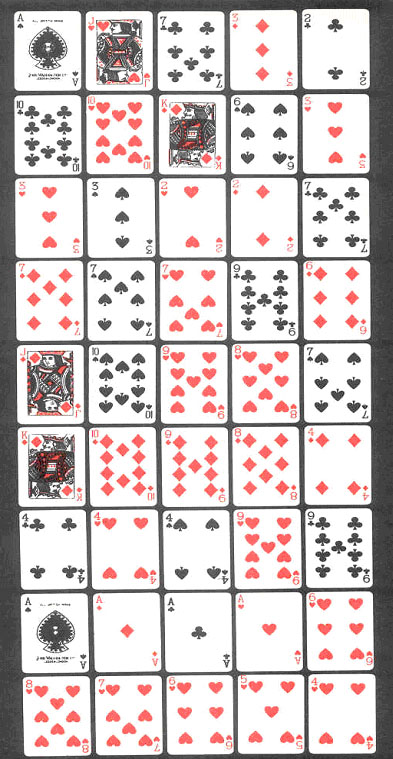POKER
POKER is No-Trumps a difficult game to learn, but by no means is it an easy one to play well because skill at the game is born only of experience coupled with some knowledge of arithmetic. Fundamentally, Poker is a game of calculating chances. It is a gambling game and cannot be played without betting.
The parent game, described first, is commonly called Straight Poker, but is more correctly Straight Draw Poker.
NUMBER OF PLAYERS
Any reasonable number may play; five, six or seven is considered the ideal number.
CARDS
The full pack of 52 cards is used. The cards rank from Ace (high) to 2 (low).
THE PLAY
Each player is dealt five cards face downwards, and the object of the game is to make the best hand by an exchange of cards, and then bet on it against the other players.
In ascending order the nine classes of poker hands, together with the approximate odds against their being dealt to a player, are:
Highest card: any five odd cards. Evens.
One Pair: two cards of the same rank and three odd cards. 15 to 11.
Two pairs: two cards of the same rank, two other cards of the same rank and an odd card. 20 to 11.
Threes: three cards of the same rank and two odd cards. 46 to 1.
Straight: any five cards in sequence, not of the same suit; an Ace may be either high or low. 254 to 1.
Flush: any five cards of the same suit. 508 to 1.
Full house: three cards of the same rank and two other cards of the same rank. 693 to 1.
Fours: four cards of the same rank and an odd card. 4,164 to 1.
Straight flush: a sequence of five cards all of the same suit: an Ace may be either high or low 64,973 to 1.
Examples of each hand are illustrated below. They are valued on the highest combination, and if the combination of two or more players is equal, by the highest holdem odd poker card. In the event of two or more players holding exactly equal hands the stakes are divided.

